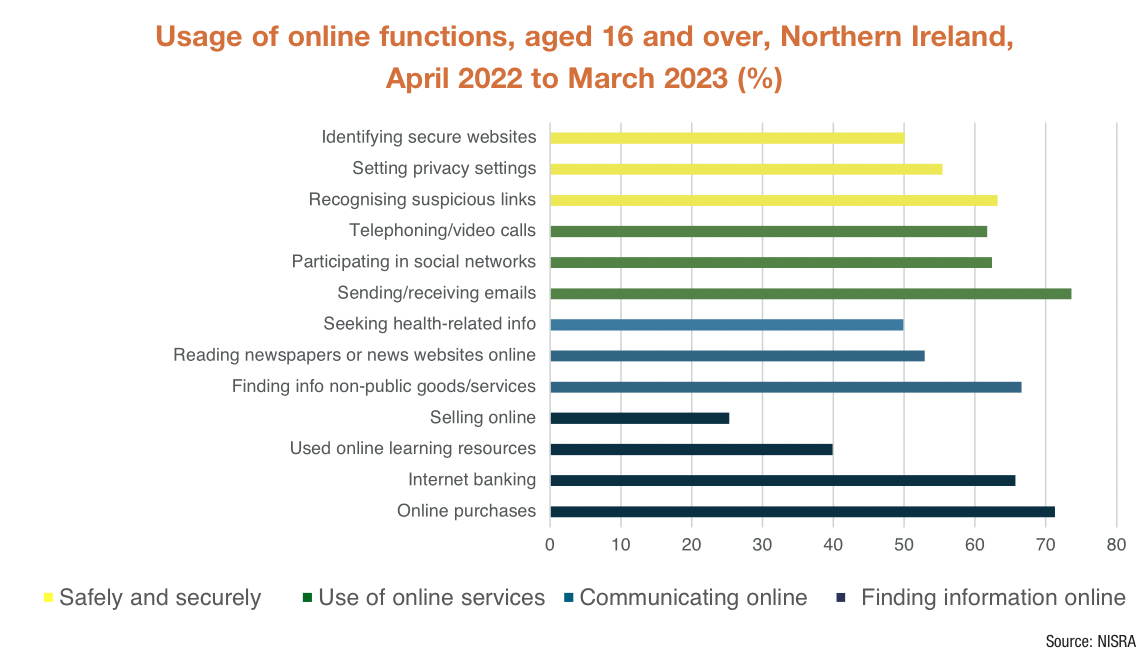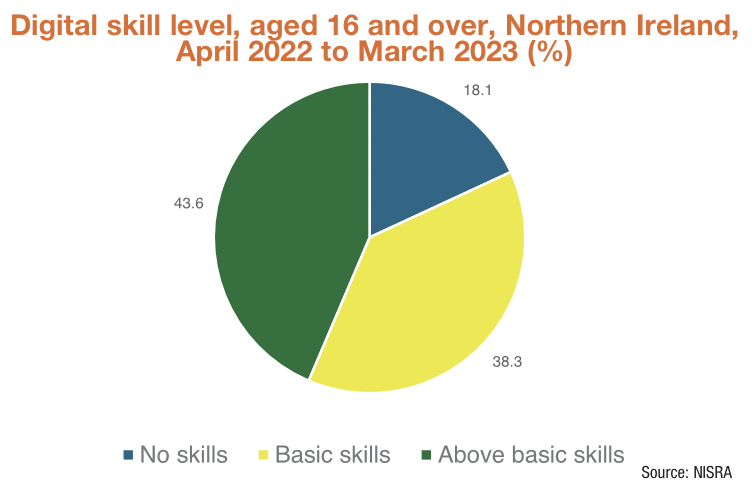Digital skills in Northern Ireland

Despite a basic level much higher than the European average, Northern Ireland has significant disparities in digital skills competency.
The Digital Skills in Northern Ireland report indicates that efforts to improve digital skills must focus on specific groups, including the elderly, those in deprived areas, and those with lower qualifications.
A recent survey reveals that 80 per cent of the Northern Ireland population aged 16 and over have at least basic digital skills, significantly higher than the European average. However, the survey, issued by the Northern Ireland Research and Statistics Agency (NISRA), highlights several significant trends that suggest a need for targeted action, particularly among specific demographic groups.
The NISRA survey, which draws data from the Continuous Household Survey (CHS) for the period from April 2022 to March 2023, provides a snapshot of digital competency across Northern Ireland.
Comparatively, 84 per cent of adults in the entire UK have basic digital skills, while only 56 per cent of the EU population aged 16 to 74 have achieved this level, based on 2023 data from Eurostat.
These figures suggest that Northern Ireland is outperforming many of its European counterparts in basic digital proficiency. However, deeper analysis reveals significant disparities within Northern Ireland itself.
Disparities
The NISRA report reveals striking variations in digital skills based on age, gender, and socioeconomic status. While 44 per cent of people aged 16 and over in Northern Ireland had above basic digital skills, one-in-five had no digital skills at all. The disparity becomes even more pronounced when examined through societal lenses.
Almost half of those aged 65 and over had no digital skills, compared to less than 10 per cent among those aged 16 to 49. This suggests a significant generational gap, indicating that older adults require additional support to develop their digital skills.
Furthermore, females are more likely to have no digital skills (21 per cent) compared to males (15 per cent).
The report highlights a stark contrast between the most and least socioeconomically deprived areas. Only 34 per cent of people in the most deprived areas have above basic digital skills, compared to 58 per cent in the least deprived areas. This disparity underscores a critical link between digital literacy and socioeconomic status, emphasising the need for policy interventions to address digital inequalities.
Use of online services
While around 71 per cent of respondents purchased goods and services online, only 25 per cent sold online. This imbalance suggests that while people are comfortable using the internet for personal purchases, fewer are leveraging it for entrepreneurial or business purposes.
Moreover, there is a noticeable gap in the use of online learning resources, with only 10 per cent of those aged 65 and over using them compared to almost 60 per cent of people aged 16 to 49. This trend indicates a need for more accessible digital learning platforms for older adults.

Finding information online
The most common online activity is finding information on non-public goods or services, with two-thirds of respondents engaging in this activity. However, the report shows a significant gap based on qualification levels.
Two-thirds of those with no qualifications report not using any online information-finding functions, in stark contrast to those with degree-level or above qualifications. This discrepancy suggests that education level plays a pivotal role in digital competency.
Communicating online
Sending and receiving emails is the most common method of online communication, with 74 per cent of respondents regularly using this feature. However, age-based disparities are evident in broader online communication, with only 25 per cent of those aged 65 and older participating in social networks, compared to 80 per cent of those aged 16 to 49. Therefore, additional support is needed amongst older people to engage with modern communication tools.
Using the internet safely and securely
With regard to cybersecurity, the most commonly used safety feature is recognising and avoiding suspicious links. However, there are notable differences across the various cohorts, for instance, those with no qualifications have a lower incidence of recognising suspicious links (22 per cent) compared to those with degree level or above qualifications (81 per cent).
The least common function for majority respondents is identifying secure websites, with those aged 65 and over also less likely to adjust privacy settings.

Addressing the digital divide
The Digital Skills in Northern Ireland report illustrates that while Northern Ireland is ahead of the European average in digital skills, there are significant gaps within the population that need addressing. The generational, gender, and socioeconomic disparities in digital skills require targeted action to bridge the digital divide.
Efforts to improve digital skills must focus on specific groups, including the elderly, those in socioeconomically deprived areas, and those with lower qualifications. By providing accessible digital training programs, fostering inclusive digital education, and encouraging technology adoption across all age groups, stakeholders can prepare the population for a digitally connected future. This, in turn, has the potential to foster greater social inclusion, economic opportunity, and resilience in the face of rapid technological change.
Digital skills
|





